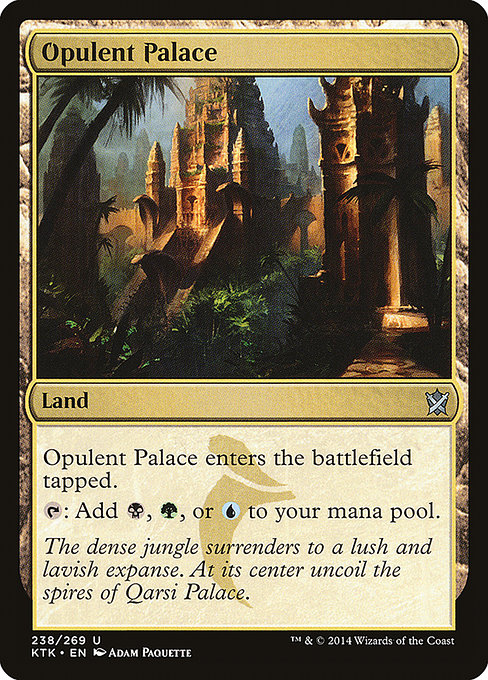Are you a Quiet Speculation member?
If not, now is a perfect time to join up! Our powerful tools, breaking-news analysis, and exclusive Discord channel will make sure you stay up to date and ahead of the curve.
There's been a ton of talk lately about reprints. Between annual Commander decks, Duel Decks twice a year, Modern event decks, and other non-Standard legal products like Conspiracy, we're seeing reprints at a greater clip than ever before.
For a long time we simply had it too good. Reprints were a cornerstone of Core Sets and, outside of that, we had very little to fear. We used the logic that if a card had a setting specific name attached to it, that they could basically never reprint it. Inquisition of Kozilek was safe.
I personally blame Batman
http://youtu.be/c8q_GJ6LqG8
Things have changed, and there is no going back.
You have to believe and know that Wizards' long-term goal is to make Modern a format that is accessible for the foreseeable future. While its prices will always be just slightly more expensive than Standard, in the long run, it's a cheaper format at the same time because the metagame doesn't shift as regularly as Standard.
You can expect a steady parade of reprints in Modern for the foreseeable future. While some of these cards will rebound the same way Knight of the Reliquary has in spite of multiple reprints, there will always be collateral damage like Bridge from Below or Chaos Warp that will take a much more substantial hit due to their niche use.
How Do We Protect Ourselves Longterm?
As my collection has grown over the years, I've delved deeper and deeper into Magic's older formats, filling out playsets for decks that I'll probably never sleeve. But once that's done, where else is there to go?
FOILS!
When you look at the cards that have been hit by multiple reprints, you'll notice a trend: eternal foil staples just don't break.
Sure, you'll get a slight dip in price, those $400 Polluted Deltas from Onslaught have slipped to a meager $360, but 10% is significantly better than the 50% hit the non-foil editions took.
We can pull data from dozens of cards at this point, and a lot of it is going to say the same thing: foil cards just don't feel the hurt that non-foils do when reprints occur.
Divergence
Keep in mind that I'm not a finance or economic major, so when I make up a term... it's made up. That said, I'd like to introduce a term that may or may not exist in the real world and may have a chance of meaning something completely different: price divergence.
What is price divergence? The definition I'm making up is the difference between a regular card and a foil card's price. Traditionally the two will follow a similar trajectory, maintaining a loose price ratio for foil vs non-foil. Eventually that price hits a point where the two numbers start to diverge from one another, breaking that ratio completely.
Let's take a look at a (fairly) recent example: Young Pyromancer.
The non-foil version of this card has held in the price range of $2-3 since it's printing. The initial foil price for Pyromancer was in around $10-12. This 4x multiplier held for a long time.
And then Young Pyromancer started making himself famous in Modern, Legacy, and even Vintage. The price diverged from a 4x premium markup to a 16x markup! Looking at the price history, you can see this all occurred around the release of Khans of Tarkir, so it's a safe bet that we have Treasure Cruise to thank for that price jump.
How many people were sitting on a pile of foil Young Pyromancers? I'm guessing not a lot.
Another great example in Magic's recent history is Jace, the Mind Sculptor.
On first printing, a foil Jace was worth a meager 2x the price of a regular--a trade I actually made to complete my playset.
Remember the peak on foil Jace? $800. Once the price divergence started to occur, Jace went up to an 8x multiplier from a mere 2x. Jace has since been diminished thanks to the release of From the Vaults: 20, but the Worldwake foil price is already recovering from it's bottoming out price of $400, currently sitting at $550.
Identifying Targets
So it seems like the advice should be to just grab foil everything and win, right?
Well, maybe not. When you're acquiring things to sell--even if it's at a much later date--you have to identify the buyer. Any retailer will tell you that the most important part of merchandising is properly identifying your customer base and stocking your store accordingly.
The good news is that you have a decent target audience for foil cards long term: eternal players, Commander players, Cube owners, Gollums, and people with inferiority complexes.
If you've ever had the joy of watching or playing paper Vintage, you know that there is a ton of dick measuring going on. While you might be excited just to see a Black Lotus in the wild, you know on a primal level that the guy playing the black bordered one is just a better person and that he paid a lot of money for that distinction. eternal players that have been playing the same deck for a long time take pride in "pimping out" their deck.
Commander players are no different. If you only need to play one copy each of all your favorite cards, why not make them fancy? The same goes for cubes. After all, if you're going to lug around a box of Magic's greatest cards to let strangers draft with them, might as well make them the most expensive versions possible, amirite?
Best Opportunity
The best opportunity to trade into foil versions of cards is during their time in Standard. As long as they're still coming out of packs, the price is less likely to go up and will likely be trending downward. After the initial rush to acquire Cube and Commander pimpage, these cards slowly decline with everything else in a set until rotation where you can expect them to bottom out.
There is one major catch, though--once a card is identified as a tournament staple, all bets are off. Remember Abrupt Decay hovering around $30 for a very long time? Then somewhere in Theros block, people caught on and the price shot through the roof to the $80 we see now.
This obviously leaves you in a precarious position: you need to identify eternal staples early but after the initial hype has worn off, and before the price starts spiking. It's a tough tightrope to walk.
With the release of every set, I make a list of the cards that can hold a premium or make the transition to eternal formats.
Here's the cards from Khans of Tarkir that I've identified as having the potential for divergent pricing. But as we've all seen time and time again, sometimes the price fluctuations in Magic don't make any sense or follow any patterns.
While some of these are obvious, others should be considered with heavy skepticism, like Sorin, Solemn Visitor.
My gut tells me that he is not quite Cube worthy or splashy enough for Commander, but he does make Vampires and black/white has been a casual playground since the days of Serra Angel/Sengir Vampire decks.
The other obvious monkey wrench in this list how do we evaluate prerelease foils going forward? Will a foil Narset, Enlightened Master prerelease foil be close in price to the non-dated one? Is From the Vault pricing where you would want to be long term?
Who knows.
TL:DR - Foilss can be a great way to shield yourself from reprint risks while giving you huge opportunities for growth over time and are also a great way to impress the ladies.




































derek what’s your opinion on only speculating on mythic rare foils in the highest condition n/m-m if you can find them at a reasonable price.I find that many are undervalued and the print runs are far less than normal rares with people wanting the original printings over the promo versions and the like.How does the card version fit into your equation?
Really depends card to card and “who’s your buyer?” There are some Mythics like [card]Sedris, the Traitor King[/card] that you’ll sit on for a very very long time without much exciting happening but then there are others like Linvala that you’ll wish you had bought a hundred of.
It’s always going to depend on the card and some cards just never strike the emotional chord that’s going to make people think they should spend more money on it.
Strongly agree with your article’s point – I have been focusing a little more on foils myself just because of my fears of reprints.
Onslaught Polluted Delta foil $360? No way…
$240-$260 in Europe (English NM-M).
Sounds like a great opportunity for some cross-continent arbitrage!
Indeed! 🙂